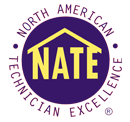

| Home | |
| Electrical & Air Conditioning Service | |
| Is My Panel Safe? | |
| Generators | |
| Surge Protection | |
| Shop |
Is My Panel Safe?
Federal Pacific (FPE) Panels and Breaker Danger

The Best Website on the Danger of a Federal Pacific (FPE) Breaker or Panel can be accessed by clicking on image. This website explains the fire and shock hazards associated with Federal Pacific Electric Stab-lok circuit breakers and service panels, provides a history of the issue, recounts research on FPE failures, and recommends replacement of the panels.
Federal Pacific Electric "Stab-Lok" service panels and breakers are a latent hazard and can fail to trip in response to overcurrent, leading to electrical fires. The breakers may also fail to shut off internally even if the toggle is switched to "off." Some double-pole (240-Volt) FPE circuit breakers and single-pole FPE Stab-Lok circuit breakers simply do not work safely. There are other panel-defects independent of the breaker problems, panel and panel-bus fires and arcing failures in some equipment. The failure rates for these circuit breakers were and still are significant. In some cases failure to trip occurs 60% of the time - a serious fire and electrical shock hazard. Failures are documented in the CPSC study and by independent research. Additional independent testing and research are on-going and are reported here.
Zinsco Panel Danger
 The Best Website on the Danger of a Zinsco Breaker or Panel
can be accessed by clicking on image.
This website discusses the electrical, fire, and shock hazards
associated with Zinsco electrical components, circuit breakers,
electrical panels, including certain Sylvania electrical panels and
breakers which are in fact of the same product design and origin.
These circuit breakers do not offer the level of overcurrent and fire
protection provided by most other electrical panels and circuit
breakers. This means homes with this equipment are at greater risk
of fire or other electrical hazard. Where Zinsco and Zinsco-Sylvania
electrical panels are discovered in buildings they should be
replaced to reduce some very real fire and shock hazards.
The Best Website on the Danger of a Zinsco Breaker or Panel
can be accessed by clicking on image.
This website discusses the electrical, fire, and shock hazards
associated with Zinsco electrical components, circuit breakers,
electrical panels, including certain Sylvania electrical panels and
breakers which are in fact of the same product design and origin.
These circuit breakers do not offer the level of overcurrent and fire
protection provided by most other electrical panels and circuit
breakers. This means homes with this equipment are at greater risk
of fire or other electrical hazard. Where Zinsco and Zinsco-Sylvania
electrical panels are discovered in buildings they should be
replaced to reduce some very real fire and shock hazards.
 |
Website developed by Business Promotion Inc.
